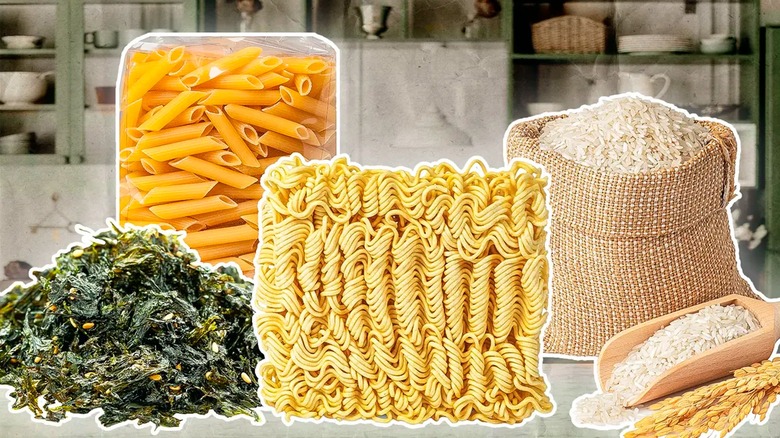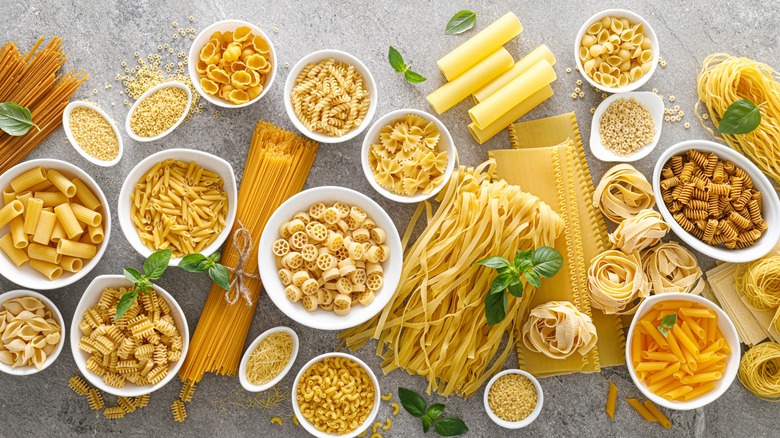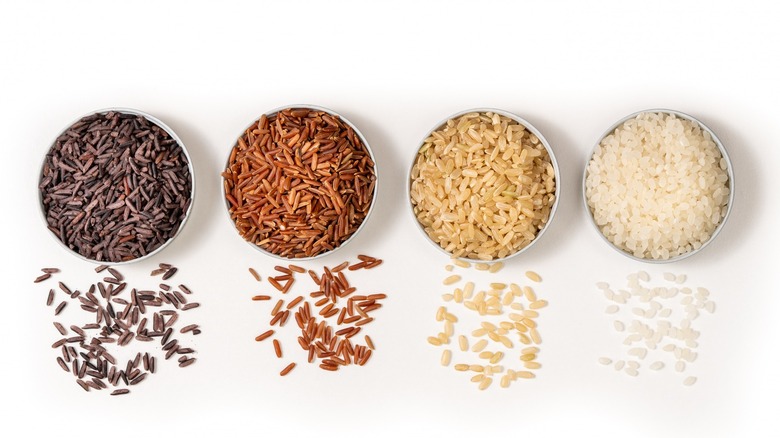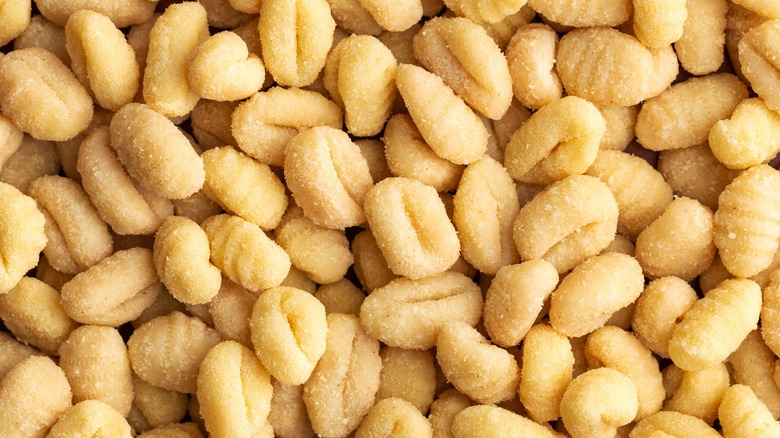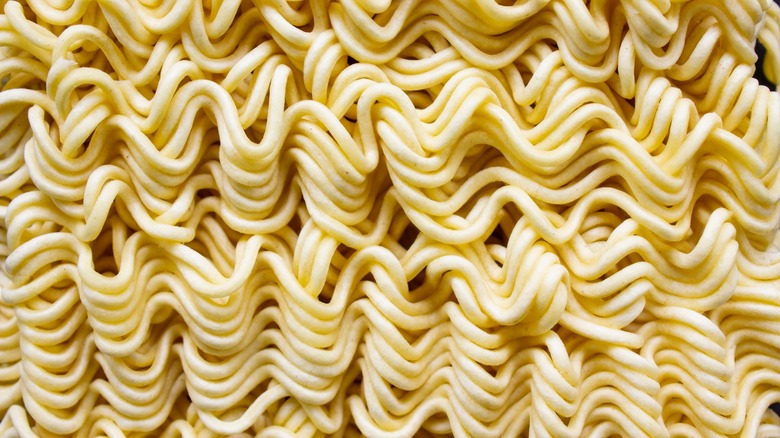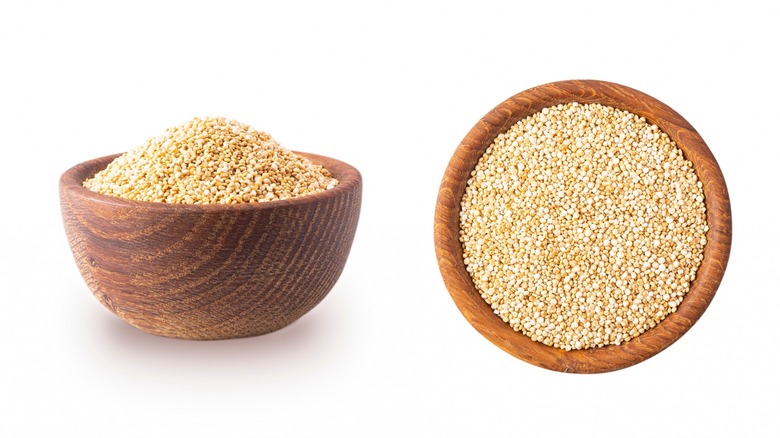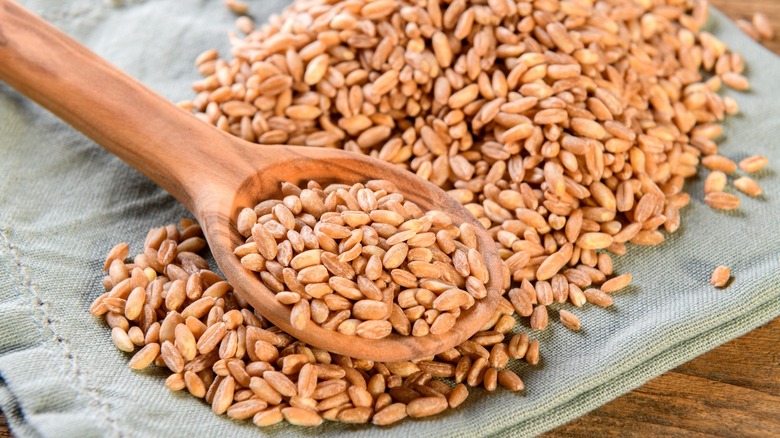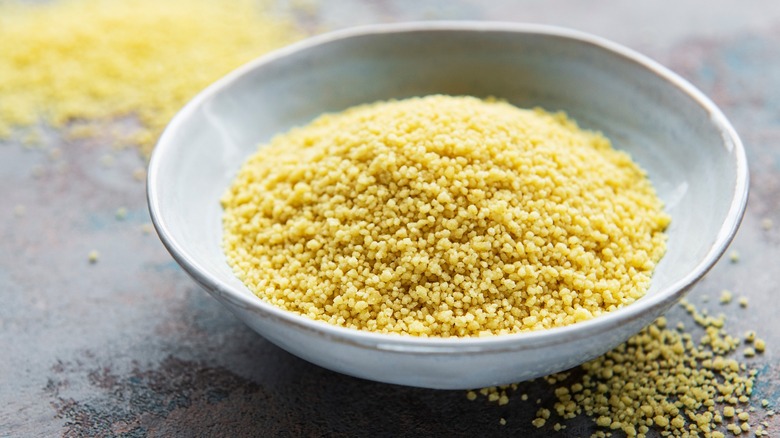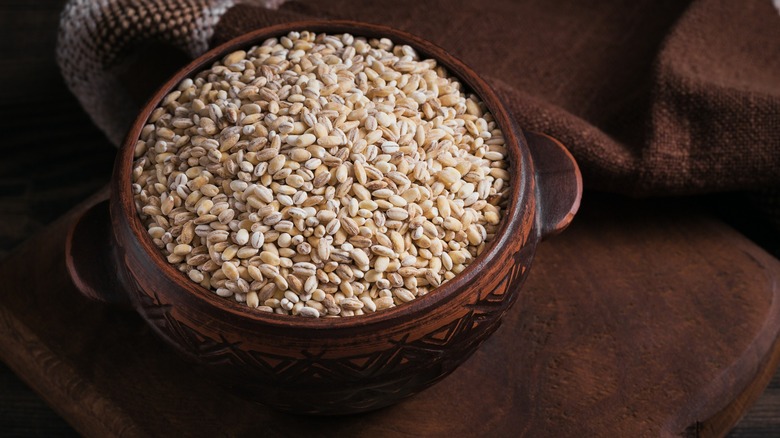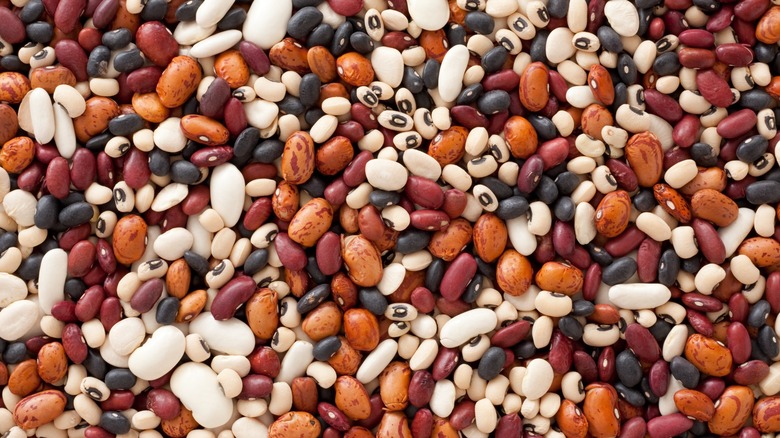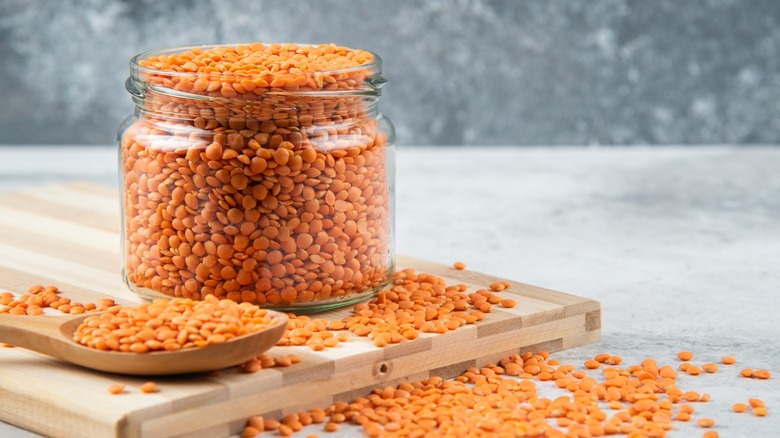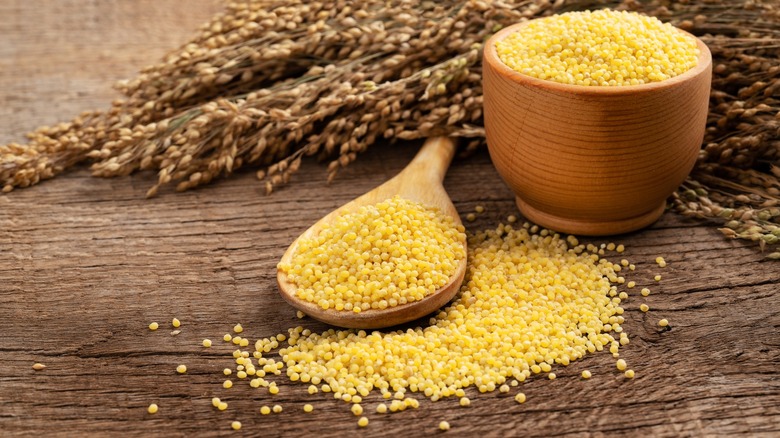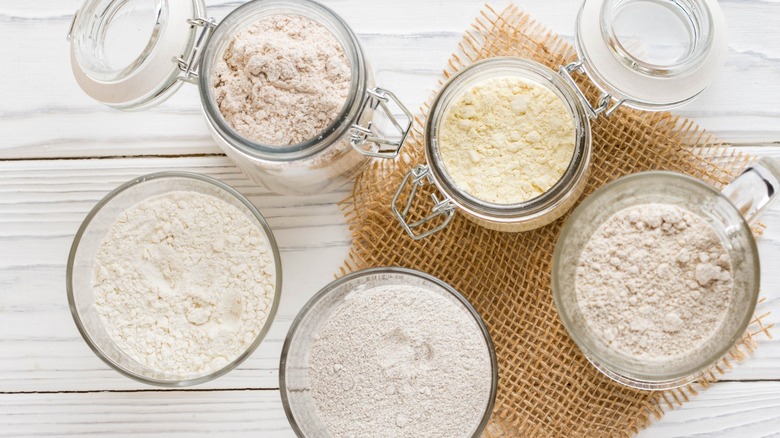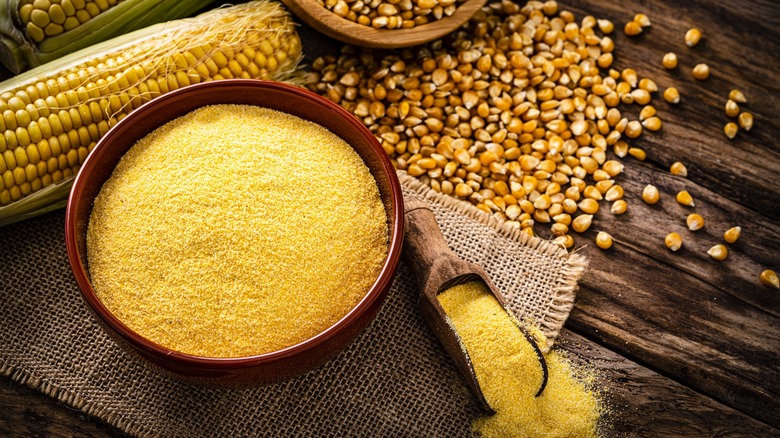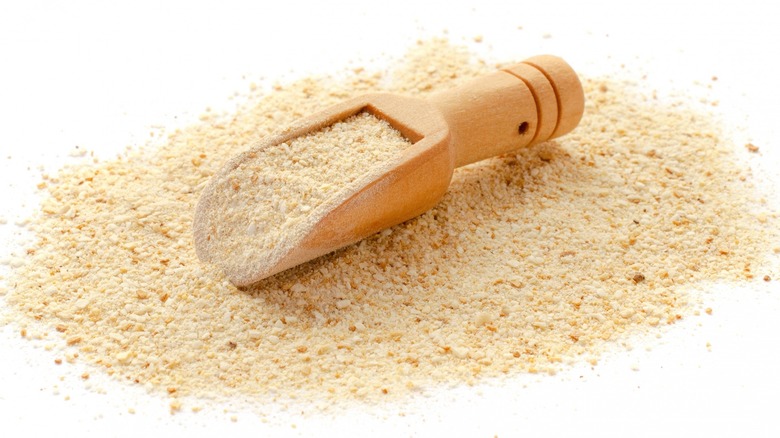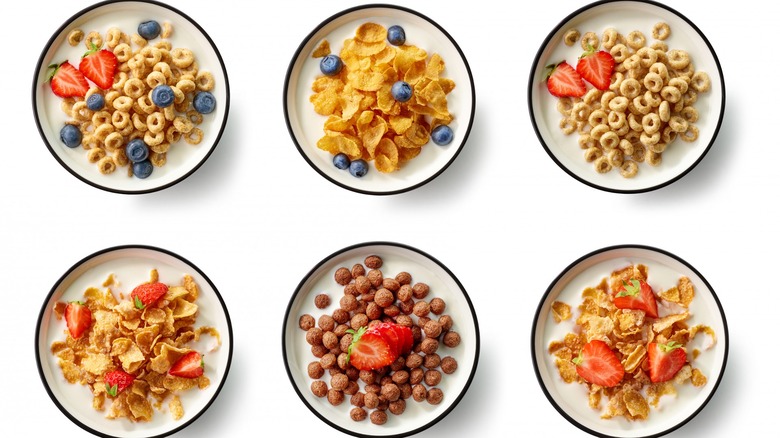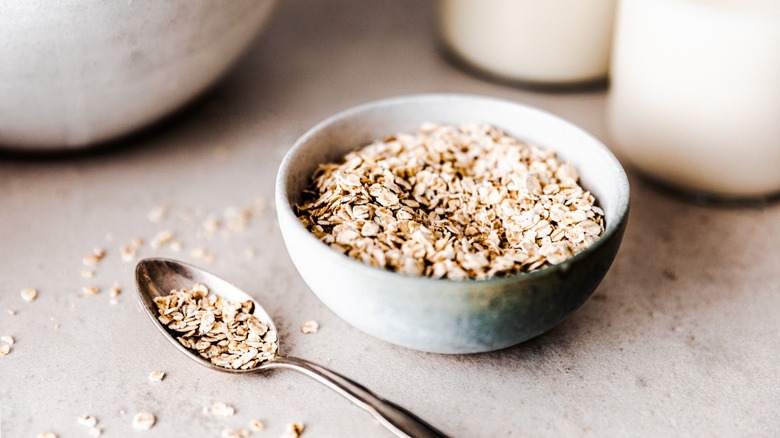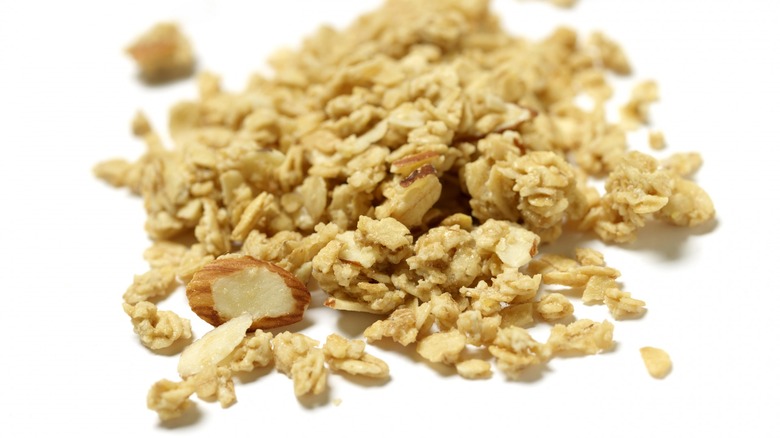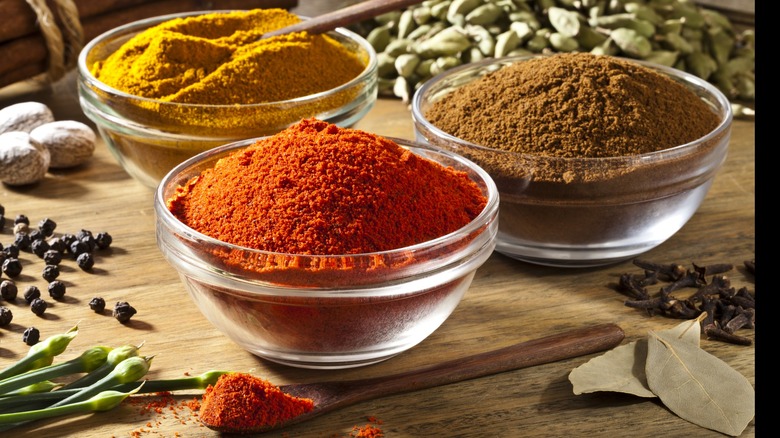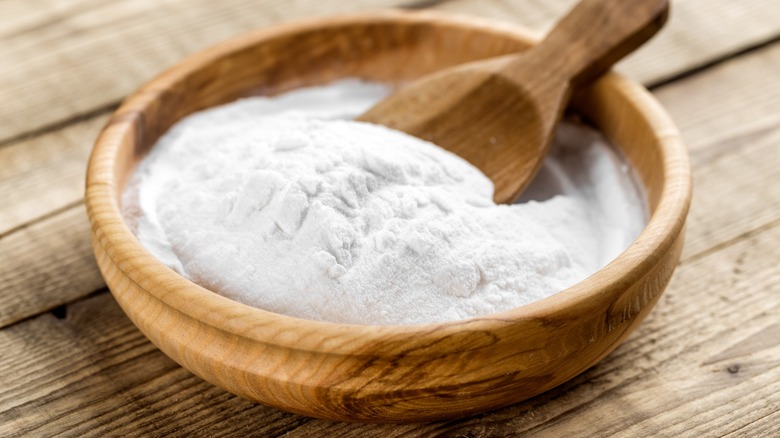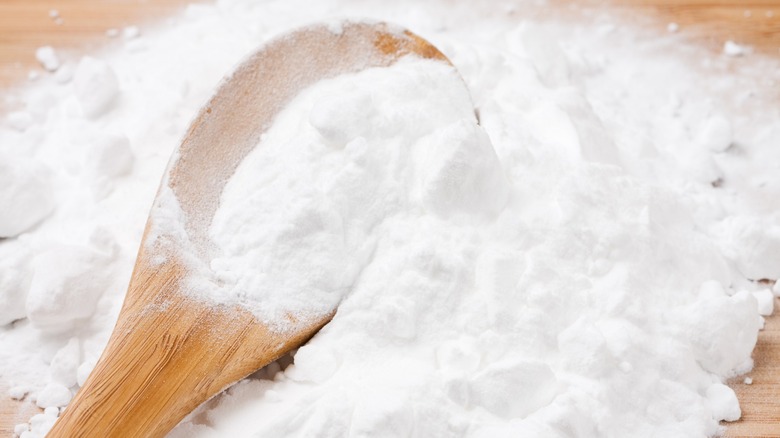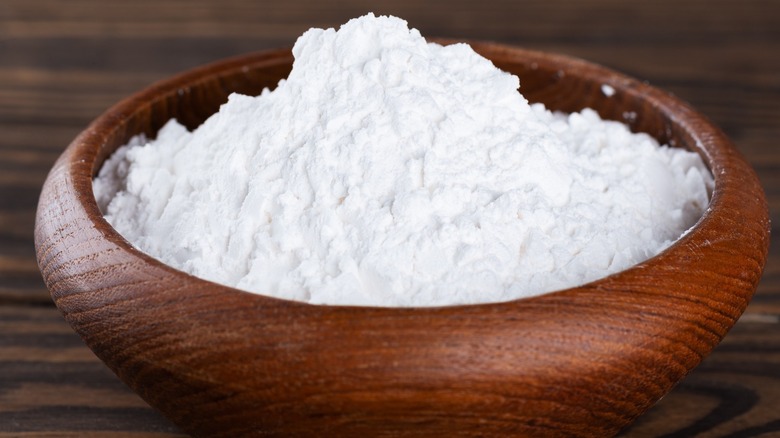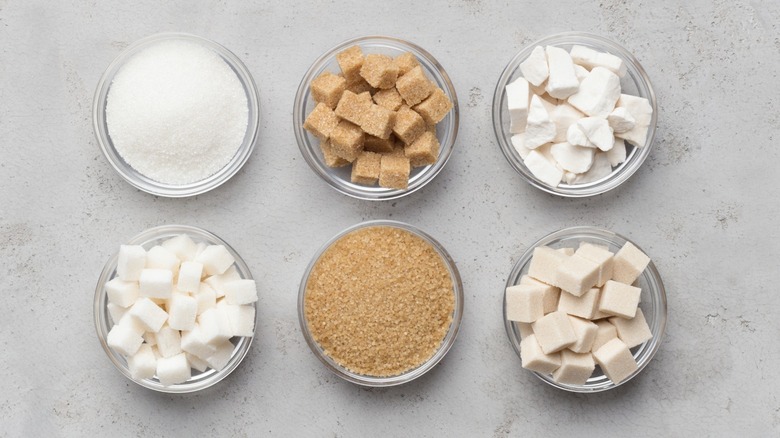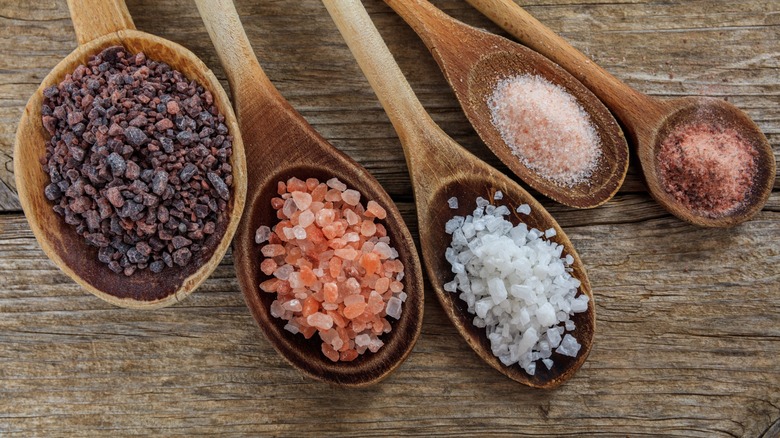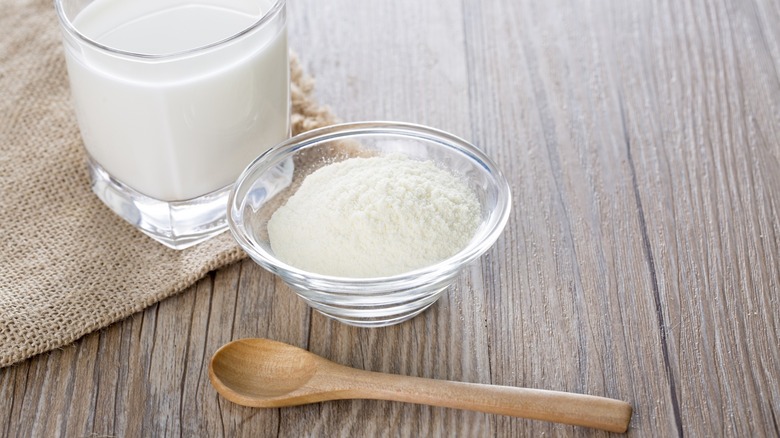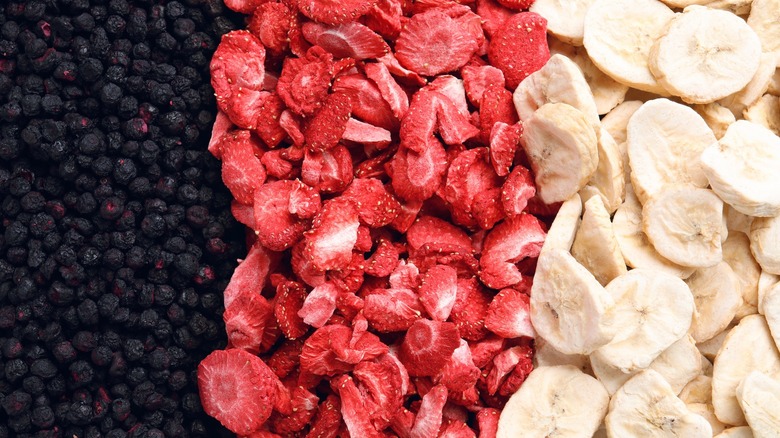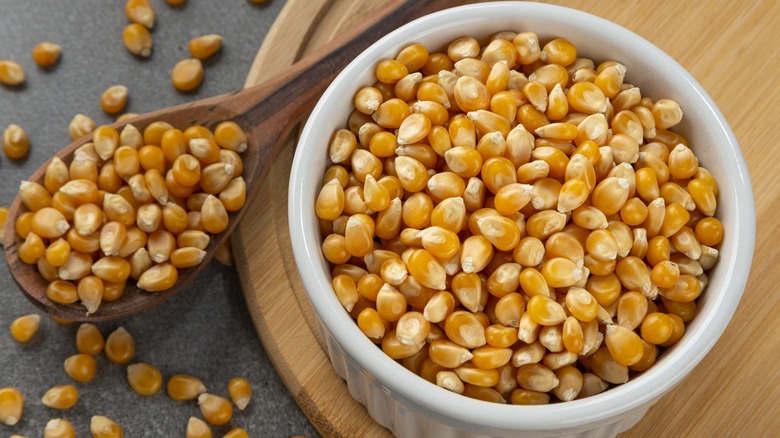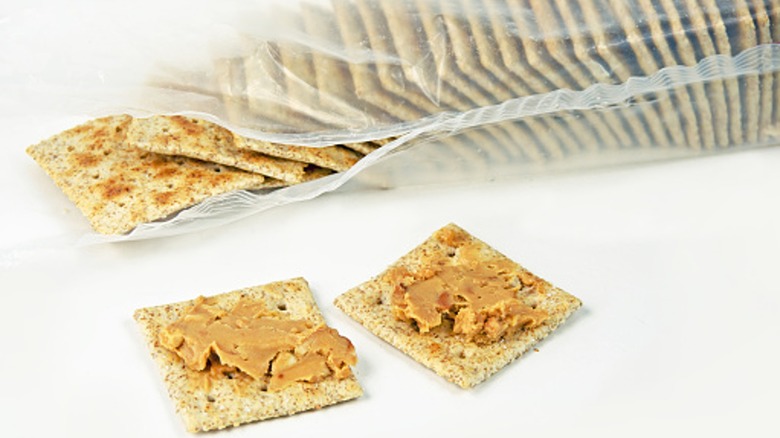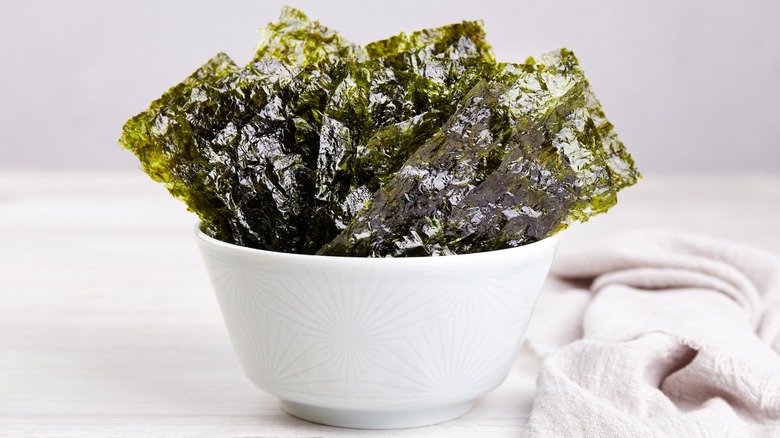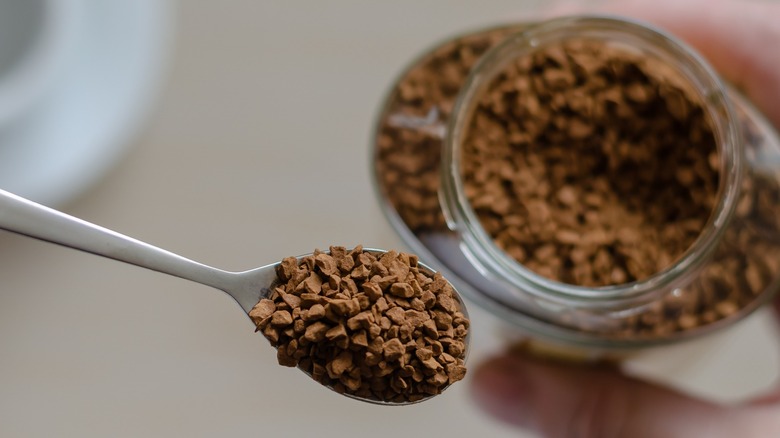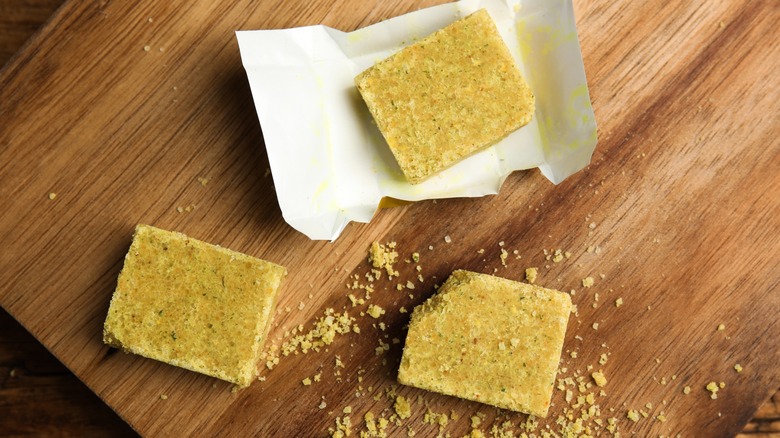30 Absolute Best Dry Goods You Should Always Have In Your Pantry
For those who enjoy whipping up delicious meals on a whim, the importance of a well-stocked pantry cannot be overstated. The ability to prepare a full meal at a moment's notice is largely dependent on the pantry staples you've chosen to keep on hand. Yet, deciding which products to prioritize can be challenging.
Opting for dry goods, as in the non-perishables devoid of liquid, is always a smart choice. That's because these pantry essentials typically have long shelf lives and are extremely versatile. From legumes and grains to spices and baking essentials, these indispensable items are the foundation of so many recipes. So, if you're looking to save time with fewer grocery store runs, be sure to keep an array of dry goods on your shelf. Let's take a closer look at the absolute best ones to keep in your pantry and dive into the many ways they can be used to make quality dishes at home.
Pasta
With so many types of pasta available, it's easily one of the most versatile items to keep in your pantry. Plus, when stored correctly, dried pasta can last for years. Pasta recipes are a great way to make quick, easy, and nutritious meals that typically call for simple yet gourmet ingredients that you probably already have in your pantry, such as olive oil, spices, canned tomatoes, or premium tinned fish. Pasta serves as the foundation for not only classic Italian dishes but also for refreshing pasta salads and comforting casseroles and soups as well.
Rice
Rice is a staple in so many cuisines around the world. By keeping various types of rice in your pantry, you'll have the foundational ingredient for an array of main courses, side dishes, and even desserts like rice pudding. Most rice has a long shelf life (white rice can last up to 2 years) and is a great addition to bulk-up soups and vegetable dishes to make a heartier, more satisfying meal. While it's advisable to keep common types on hand like jasmine and basmati, don't rule out stocking up on risotto rice like arborio and carnaroli as well.
Gnocchi
Gnocchi, though frequently mistaken for pasta, is technically a type of Italian dumpling. It's a shelf-stable and versatile ingredient that you should be using more of. If boiling it isn't to your taste, try roasting gnocchi in sheet-pan dinners instead. This technique adds a twist to your roasted vegetable dishes, enhancing both texture and flavor. Alternatively, you can prepare it in the traditional way and toss it in your preferred pasta sauce, creating a quick and satisfying meal that breaks away from your ordinary pasta routine.
Ramen noodles
Instant ramen is a tried and true ingredient, known for its simplicity and budget-friendly appeal. While often associated with college students, the versatility and extended shelf life of dried ramen noodles make them a valuable addition to any pantry. Plus, there are loads of fun recipes to try with ramen. For example, experiment with adding ramen to canned soup. And you can actually eat instant ramen right out of the package, which is not only handy in emergencies but makes a great addition to salads, such as this crunchy ramen noodle salad recipe.
Quinoa
Quinoa is a smart choice to consistently keep stocked in your pantry not only for its remarkable versatility but also for its wealth of essential nutrients, including protein, fiber, vitamins, and minerals. Beyond being an excellent foundation for vegetarian and vegan dishes, it's an ideal choice for individuals adhering to a gluten-free diet. You can use this seed (as it turns out, it's not a grain) in recipes that range from cookies and energy bars to salads and burgers to smoothies and breakfast bowls.
Farro
If you're not acquainted with the ancient grain farro, it's high time you give it a try. Uncooked farro will last at least 6 months in the pantry. Preparing farro typically involves boiling it in water, similar to cooking many other grains and pasta. However, rinsing, soaking, and toasting are usually advised before boiling. It has a pleasant nutty flavor and a nice al-dente texture, making it an excellent addition to soups and salads or as a substitute for risotto rice as demonstrated in an acorn squash farro risotto recipe. Plus, it's loaded with nutrients including iron, fiber, and magnesium.
Couscous
Couscous is a Mediterranean diet staple that's a great addition to all pantries. It comes in two main varieties: couscous and Israeli couscous. The one labeled as simply couscous is similar to rice in its size and texture but is made from semolina, a type of wheat flour. Israeli couscous is also made from semolina but is much larger and could be described as small pearl-shaped pasta balls. Grocery stores offer various flavored couscous options, such as garlic and lemon, making it an easy, instant side dish.
Barley
When you hear the word barley, you might immediately associate it with beer or medieval times, but its history extends even further, dating back to 8000 BCE. Its nutritional value, especially its high fiber, is one of the main reasons you should always keep barley in your pantry. This ancient food is a great addition to roasted vegetable dishes, salads, stews, and soups like this vegetable beef barley soup recipe. Stocking up on barley allows you to create nutritious and satisfying meals while also providing you with a reliable and long-lasting food source.
Dried beans
Because they are such a great source of protein, it's a good idea to always keep a bean variety in your pantry. Beans from a can may be easier and faster than cooking beans from scratch but consider buying dried boxed beans instead of canned next time you make a grocery run. Though it requires a bit more time, the result will be firmer, more flavorful beans that you can customize to your own liking and dietary needs–particularly useful if you're watching your sodium intake. Not only that, they're usually more cost-effective than their canned counterparts.
Lentils
Like beans, lentils are seeds from legume plants. However, we're putting them in their own category because there are in fact differences between lentils and beans. While both offer significant nutritional benefits, studies have shown that lentils have more power to lower cholesterol levels, per Cleveland Clinic. There are also various types of lentils, each possessing its own unique flavor profile, making them suitable for a wide range of recipes from around the world. So in addition to your preferred beans, why not consider adding lentils to your pantry? This addition can bring extra variety and flavor to your legume collection.
Millet
This ancient grain may not be on your radar at the moment, but there's good reasons to start cooking more millet. For one, it's high in many nutrients but is especially rich in calcium, containing more of it than any other cereal grain. Moreover, millet can be conveniently stored in your pantry for up to two years. The texture of this seed resembles that of couscous or bulgur wheat, and it readily soaks up flavors, making it an adaptable ingredient suitable for a diverse array of breakfast, lunch, or dinner dishes.
Flours
You've probably noticed the multitude of flour options adorning the grocery store shelves. Regardless of your baking expertise, it's a prudent choice to keep at least one type of flour in your pantry–all-purpose flour. As the name implies, it's incredibly versatile and suitable for a wide spectrum of culinary applications. But if you're a more seasoned baker or like to cook things from scratch there are plenty of other types of flours to consider as well, such as self-rising flour, bread flour, or gluten-free alternatives like almond flour.
Cornmeal
Depending on the coarseness of your cornmeal, which is made from dried ground corn, you can make a variety of recipes with this ingredient, from cornbread to creamy polenta. Having cornmeal in your pantry is a smart choice because it has a long shelf life and offers the opportunity to explore a wide range of dishes that encompass Mexican cuisine, Southern classics, and Italian comfort food. Whether you're an avid baker or simply enjoy trying new recipes, cornmeal is a versatile and valuable ingredient to have at your disposal.
Breadcrumbs
There are several types of breadcrumbs to consider keeping in your pantry. Panko, for instance, is a popular choice, used for its ability to create a crunchy coating on fried foods. On the other hand, Italian-style breadcrumbs are perfect for dishes like chicken parmesan and meatballs. So whether you're preparing a crispy coating for fried foods or using them as a binding agent, breadcrumbs are a valuable and adaptable ingredient to keep on hand. Making breadcrumbs a pantry staple is a practical choice that can add convenience to your cooking.
Cereal
Breakfast cereal is one of the most convenient and affordable quick meals out there. Although primarily designed for breakfast, it's no secret that many of us have indulged in a bowl for dinner or a late-night snack from time to time. While there are plenty of cereals you shouldn't be eating that are full of sugar and preservatives, nowadays there's an abundance of accessible, healthier brands. These healthier choices are often packed with essential nutrients, notably fiber, making them a nutritious and readily available snack. Plus unopened cereal rarely goes bad when properly stored.
Oats
For generations, people have chosen oats as their morning staple, and there's a good reason for that. Oats make an ideal breakfast food due to their high levels of carbs, fibers, proteins, essential amino acids, vitamins, minerals, and antioxidants. These grains make for a powerful boost to your morning. Maintaining a stock of oats in your pantry ensures you always have access to one of the healthiest, budget-friendly, and effortless foods you can eat every day.
Granola
While granola is primarily composed of rolled oats, we're putting it in its own category because its crunchy texture and its uses differ greatly from oatmeal oats. It's typically sweetened and mixed with nuts, flavorings, and often dried fruit. You can always snack on granola on its own, making it an easy go-to pantry item, or some other tasty ways to use granola include topping yogurt, making energy balls or granola bars, making a pie crust, or using it to make a trail mix.
Dried herbs and spices
It goes without saying that any home cook should have an extensive selection of dried herbs and spices at their disposal. Some essential spices to keep in your pantry include cinnamon, paprika, chili powder, oregano, cayenne, garlic powder, and ground ginger, just to name a few. With your favorite dried herbs and spices readily on hand, you'll be able to season a wide range of recipes. Plus, these powerful powders possess a remarkable shelf life, retaining their flavor for extended periods before they begin to lose their flavor.
Baking powder
Admittedly, this item is primarily essential for bakers. However, if you ever intend to embark on even the simplest baking tasks, such as making a batch of cookies or a birthday cake, having baking powder readily available is a good idea. Baking powder is essentially a chemical leavening agent used to help dough and batter rise, resulting in the delightful lightness and fluffiness characteristic of baked goods. It's important not to mistake it for baking soda, another useful pantry staple we'll discuss below.
Baking soda
Even if you don't consider yourself a baker, chances are you already have baking soda in your pantry. If you don't, it's a pantry staple you should consider keeping on hand. Baking soda serves a multitude of everyday purposes beyond baking. Unlike baking powder, it boasts a wide range of practical applications, from cleaning to fixing an overly sour dish. Other unexpected uses for baking soda include making boiled eggs easier to peel, neutralizing odors, and speeding up the browning process when sautéing onions.
Starches
In certain recipes, the inclusion of starches is necessary to achieve thickening and binding effects. This is notably frequent in dishes like sauces and stews. If your home cooking often ventures into these realms, it's advisable to stock various starches in your pantry. Different types of starches have varying properties such as thickening power and heat tolerance. Among the most popular and versatile starches readily available in the market are potato starch, cornstarch, and tapioca starch.
Sugars
Chances are, you already stock regular white sugar in your pantry. But perhaps you've never considered just how many types of sugar there are to sample. Sugar isn't just about adding sweetness. It has the potential to add layers of complexity to your baking and beyond. In addition to the familiar white, brown, and powdered sugars, why not introduce some unexpected sugars into your repertoire? Take, for instance, muscovado sugar, which has a robust molasses undertone that is delightful in dishes ranging from sticky toffee pudding to barbecue sauces.
Salts
Arguably, salt is the most indispensable ingredient in your pantry. It's a component in nearly every recipe and enhances the flavor of practically everything it touches. No doubt you already have table salt but like sugar, there are many types of salt to explore. Kosher salt is a useful one to keep in stock, especially for salting meat. But if you want to get a tad more gourmet, keep an array of salt on your pantry shelves that include sea salts, Himalayan pink salt, and smoked salt.
Powdered milk
The handiness of having powdered milk in your pantry is unmatched. Given that fresh milk has a limited shelf life and may not always be readily available, powdered milk is a reliable alternative for adding instant creaminess into your recipes. Whether you're preparing a dessert, a savory white pasta sauce, or a classic macaroni and cheese dish, powdered milk can amp the creamy flavor. It can also be used as a coffee creamer and adds depth to the flavor of browned butter, making it a versatile and valuable addition to your pantry.
Freeze-dried fruit
The reason you should keep freeze-dried fruit in your pantry instead of dehydrated fruit is simple. Dehydrated fruit is dried using heat, a process that can compromise much of its nutritional content. In contrast, freeze-dried fruit retains nearly all of its nutrients, making it the superior choice for preserved fruit to keep on hand. So, whether you find yourself in a situation where fresh produce is scarce or you simply haven't had the chance to make a market run, you'll still have access to nutrition-packed fruits to add to your cereals, salads, and baked goods.
Popcorn kernels
Unlike bagged popcorn, keeping a stash of popcorn kernels in your pantry will allow you to have freshly made popcorn at any time, a gourmet snack indulgence that shouldn't be overlooked. Dry kernels will surprisingly never expire when stored properly (although their quality may diminish over time, so it's best not to wait too long). Customize your homemade popcorn with your own inventive seasonings and flavors or try a recipe like this spicy citrus popcorn.
Crackers
Why should you always have a box of crackers in your pantry? Well, crackers are obviously great for charcuterie boards, as a late-night snack pairing with your favorite cheese, and to add a little sustenance to a soup dinner. But beyond its "girl dinner" potential, crackers have other unexpected uses as well. For instance, you can use them to make a pie crust, a crumble topping for a casserole, or even to make mini pizzas. With so many types to choose from, the world is your oyster cracker.
Nori
While there are many types of seaweed out there, nori is the easiest one to find on American grocery store shelves. The dried sheets of seaweed are not only used to make sushi but also make a unique crunchy and nutritious snack. Nori is a superfood and an excellent source of iodine. So if you're not using iodized salt, incorporating a bit of seaweed into your diet is a great way to ensure you receive this essential mineral for your health, making nori a valuable addition to your pantry.
Instant coffee
If you're a caffeine enthusiast, then you probably already keep emergency instant coffee in your pantry, just in case. However, even if you're not a coffee drinker preparing for a potential doomsday scenario, instant coffee can be a valuable addition to any pantry. It's one of those foods that never really expire and can be used in ways other than brewing it. It can be used to add a depth of flavor to chocolate cakes and brownies, to make coffee-flavored icing, used in dry rubs for meat, or even incorporated into a barbecue sauce.
Bouillon cubes
If you're not yet acquainted with bouillon cubes, they are essentially little squares of dehydrated stock capable of infusing instant flavor into soups, stews, and sauces. With an extended shelf life, they are not only a valuable asset for emergency food preparations but can be used to add depth and complexity of flavor to a wide range of dishes anytime. Cooking with bouillon cubes opens up a new world of flavor possibilities, making it one of the best pantry staples for home cooks.
